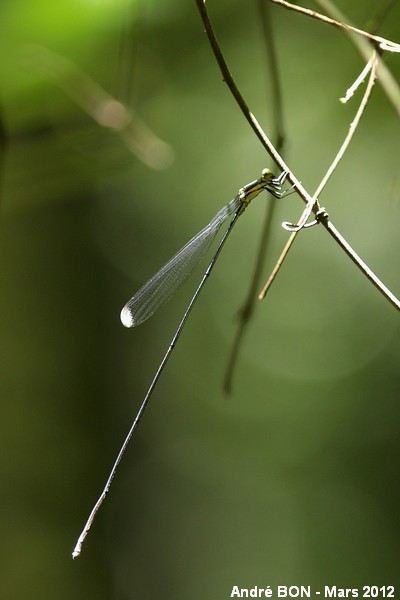

| Mecistogaster lucretia (Drury, 1773) |


|
|
Scientific name: Mecistogaster lucretia (Drury, 1773) Common name: French name: Order: Odonata Suborder: Zygoptera Family: Pseudostigmatidae Wingspan: Abdomen length: 117-137 mm for males, 85-110 mm for females. Wingspan: 102-136 mm for males, 98-140 mm for females. Biotope: Semi-shaded areas in primary and secondary forests. Geographic area: Ecuador, Peru, Venezuela, Guyana, Suriname, French Guiana, Brazil, Argentina. Flight time: All year round. |
Damselflies of the Pseudostigmatidae family are all found in the Neotropical zone except one African species, remaining indicator of the period before the Gondwana breaks up to form several continents. They are characterized by their large size and by the lack of pterostigma on their wings, sometimes replaced by a pseudostigma covering several cells. There may be a patch covering the entire wing tip. Adults feed on spiders they grasp from their web using their agility in flight to avoid touching the sticky silk threads (they are called Helicopter Damselflies). Larvae grow in phytotelmata, that's to say water accumulated in plants, tree holes, Bromeliaceae, etc. The Mecistogaster genus is characterized by narrow wings, vein A1 is not forked and it is only separated from the posterior edge of the wing by one or two rows of cells. This genus includes 11 species. Only males of 3 species have an abdomen longer than 80 mm. Male Mecistogaster lucretia shows a small extension of the wing on the anterior edge near the pseudostigma. The pale humeral and antehumeral stripes differ in length. The antehumeral stripe (upper stripe) is shorter than the humeral stripe (lower stripe), of about one third of the humeral stripe length. Male Mecistogaster linearis does not show any extension on the anterior edge of the wing and the humeral and antehumeral stripes are almost the same length (difference is less than 15%). You can tell Mecistogaster amalia apart with the black stripe on the lower suture, on the lateral side of the thorax, which is interrupted just before the hind leg coxa. |
| [To know more about the Mecistogaster lucretia] [Next picture] [Top] |

|
I have shot this picture while walking along the Monts-la-Fumée footpath next to the small village de Saül. The length of the abdomen is really impressive. I have measured it on the picture to 2.3 times the length of the wing. I think that it is more than 10cm. This great length and the thin abdomen tip indicate one male. The hind wing clearly shows a front extension next to the pseudostigma and I have measured (on the picture) a difference of length of 31% between the antehumeral stripe and the humeral stripe. So everything matches to indicate Mecistogaster lucretia. |
| [To know more about the Mecistogaster lucretia] [Previous picture] [Top] |

|
The front extension of the wing is less visible on this picture as the front edge of the hind wing is slightly hidden by the fore wing. However it is visible by zooming on the full size picture. I have measured a difference of length of 33% between the humeral and antehumeral stripes. This one is also one male Mecistogaster lucretia. |